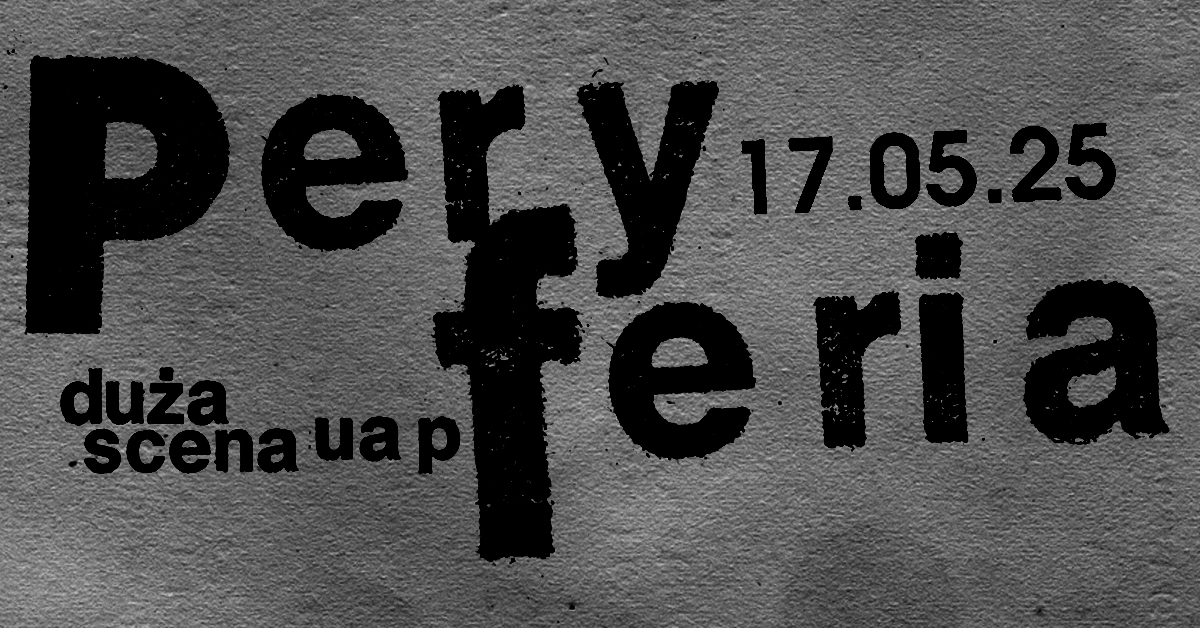Peripheries
Barbara Stańko-Jurczyńska, Rafał Jakubowicz, Jerzy Norkowski, Marta Zgierska, Arek Pasożyt, Rafał Górczyński, Wojciech Dada, Radek Radar Włodarski, Aleksandra Kosior, Dorota Jonkajtis, Sebastian Trzoska, Krzysztof Balcerowiak, Paweł Kaszczyński, Marcin Gorgolewski
Duża Scena UAP Gallery, 24 Wodna Str.
Opening: 17.05.2025, 18:00
Duration of exhibition: 17.05 – 1.06.2025
Peripheries or maybe What are we looking for on the outskirts of imaging and naming?
The existence of the poetic word and the work of art contains a statement that has an independent character – and just as an independent sentence requires a dialectical representation – so a work of art requires an interpretation, although no interpretation can fully exhaust it.
Hans Georg-Gadamer, Language and understanding
Marko Polo describes the bridge, stone by stone.
- But which stone supports the bridge?
- The bridge is not supported by this or that stone — Marko replies — but by the line of the arch formed by them.
Kublai Khan remains silent, meditating. Then he adds: - Why do you speak to me of stones? I am only interested in the arch.
- Without stones there is no arch.
Italo Calvino, Invisible cities
The world is a family of relationships – a whole that we experience as a special phenomenon – the sensitivity of objects towards other objects. We often demand an answer to the question about the nature of objects themselves; what does the potential fullness of their existence consist of, excluding humans? In reality, they are the only available thing that only builds the imagination of our world. Objects live next to us. On the margins, on the outskirts of our everyday functioning. They actually fill these spaces and do not seek our attention in the slightest. It is we who provoke situations where specific objects, at the expense of others, have called out to us and built a relationship with us. We impose our will on them so that they become part of a fixed and named reality. What interests us is the superficial similarity of these privileged objects to our egoistic needs and natural instincts, where at the same time we push aside everything that we do not see, do not want to see or, despite our best efforts, involuntarily escapes our field of vision. In this way, a rigidly marked boundary appears separating things from things – a point from which there is no turning back. Unless, of course, we are actually looking for something that we are unable to predict; we are moving towards something that happens independently of us, but the joke is that it happens with us and for us. And we do not ask questions with a calculated thesis, because these are most often intended to confirm us in the illusory conviction of the correctness of our judgments and opinions. Perhaps this is one of the most difficult works to do: observing objects as they are (along with what they come to us with).
What we are dealing with is, in fact, an active projection of reality – regardless of whether we call it the shadow of Plato’s cave, Buddhist maya (Sanskrit: illusion, delusion), or a biological-evolutionary deepfake produced by our senses, which balances on the border of what we recognize and what we do not. Good form cannot be seen [and] similarity is a prerequisite for seeing the difference.1 The question that emerges from this is: do we want to see it?
So let’s assume a certain thought experiment: if something already catches our attention (or we catch the attention of something) and we give it some meaning and a specific value on this account, is this thing more real than others?
Our problem is that the power of thought enables us to construct symbols of things that are different from the things themselves. This ability also includes the creation of symbols, certain representations of ourselves that are not ourselves. Since such a representation is much easier to grasp than reality, and a symbol lasts much longer than a fact, we learn to identify ourselves with representations of ourselves. Hence the subjective feeling of “me” who “has” a mind, the feeling of a subject closed within itself, to which – against the will – experiences are given.2
Objects look at us from hiding. They do not judge the spirit of our times, the ubiquitous zeitgeist, the weight of which we gradually build day after day by casually throwing our own pebble into its (our) garden. We do not feel their gaze on our backs, but they patiently and calmly observe how we try to navigate our everyday life. The question in the title does not have a clear answer. In fact, there is no answer to it at all if we expect some measurable effect or tangible evidence. For a very simple reason: creative action is an action towards something that cannot be predicted or planned. We can only count on the fact that what we have noticed and the idea that has come to us as a result of this perception will turn into an image (in the broadest sense of the word). More of an image of movement or vectors that define individual meanings and objects than specific representations or images of specific things.3
We are not able to see the whole picture. We only have fragments – sensitive particles of meaning – and although we can throw them into a set called “the whole”, the whole is more than the individual elements that build this set-bridge.
Sebastian Trzoska
1 R. Arnheim, Sztuka i percepcja wzrokowa. Psychologia twórczego oka
Art and Visual Perception: The Psychology of the Creative Eye, transl. J. Mach, Łódź, 2022
2 A. W. Watts, Droga Zen The Zen Way, transl. S. Musielak, Poznan 2020
3 The perception and representation of an object does not aim to solve the problem of representing the object (its image), but to create an image as a circumstantial whole.

- Author: o.petrenko
- Published on: 14.05.2025, 11:25
- Last edit: 14.05.2025, 15:40

